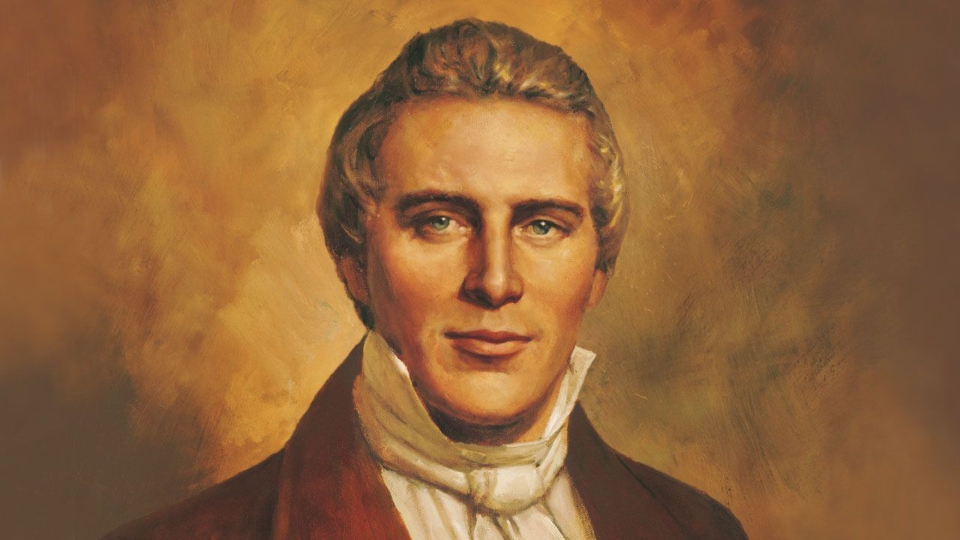
JSP-volume-14
Artwork depicting Joseph Smith by Del Parson. The Joseph Smith Papers has released “Documents, Vol. 14,” the 26th of 27 volumes in the series. 2023 by Intellectual Reserve, Inc. All rights reserved.
This story appears here courtesy of TheChurchNews.com. It is not for use by other media.
By Trent Toone, Church News
In early February 1844, Joseph Smith received a friendly letter from Church member Joseph L. Heywood, inviting him and his family to visit Heywood in Quincy, Illinois.
The Prophet replied with gratitude and kindness, but politely declined the invitation. He expressed concerns about growing hostility in surrounding communities and possible abduction to Missouri if he left the safety of Nauvoo, Illinois.
President Smith also tried to dispel fear and offer encouragement to his friend.
“Although the mobocrats of this county breathe out their shame with a continual foam and threaten extermination, the citizens of Nauvoo are at peace, they fear no danger,” Joseph wrote. “In fact, things in general seem prosperous and pleasing, and I never saw a better feeling amongst the Saints than at the present time.”
The personal correspondence reflects both the Prophet’s outward optimism and growing anxiety in the final months of his life. Even as Joseph Smith promoted peace, taught new doctrines and sought to build up Nauvoo and the Church, he and the Latter-day Saints faced escalating regional tension, disputes within the Church and city, apostasy and broken friendships.
Problems were starting to increase, said Adam H. Petty and Jessica M. Nelson, volume editors and historians for “Joseph Smith Papers, Documents, Vol. 14, 1 January-15 May 1844.”
“This is the calm before the storm,” Petty said. “Things are just starting to rev up leading to the martyrdom.”
“Documents, Vol. 14,” was released on Monday, April 17, and is the 26th of 27 volumes in the Joseph Smith Papers series.
What’s in ‘Documents, Vol. 14’?
The new Joseph Smith Papers volume features 99 documents, including letters, deeds, accounts of discourses, minutes of meetings, memorials to the nation’s leaders, poems and other documents that showcase a tumultuous period in Joseph Smith’s life and illustrate a region on the brink of civil war.
Of the 57 letters in the volume, the most frequent recurring topics involve:
- Joseph’s presidential campaign.
- Land transactions.
- The affairs of the Council of Fifty.
- The efforts of proselytizing missionaries.
Here are some of the interesting documents found in the latest Joseph Smith Papers volume, according to Petty and Nelson.
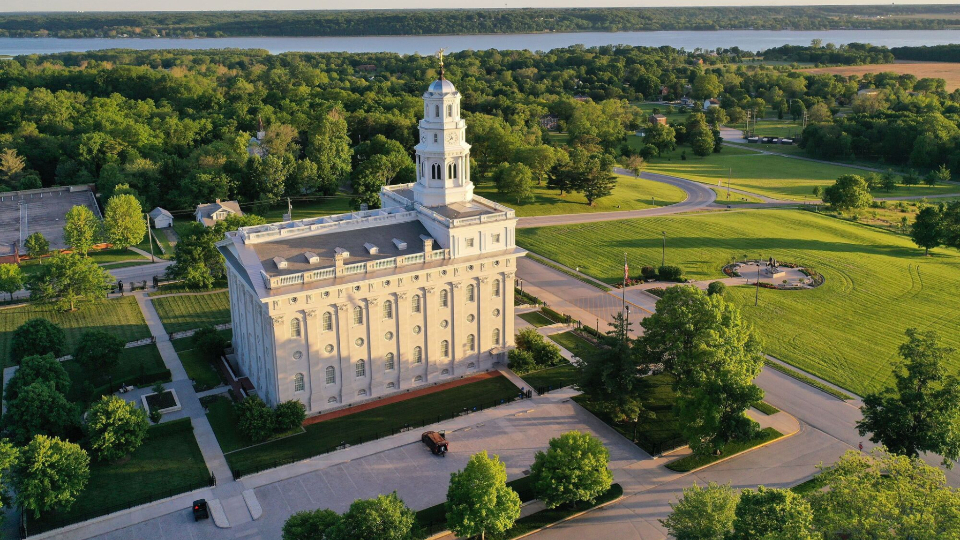
JSP-volume-14
An aerial view above the Nauvoo Illinois Temple in Nauvoo, Illinois on Saturday, May 29, 2021. The Joseph Smith Papers latest volume, “Documents, Vol. 14,” features documents from the final months of Joseph Smith’s life. Photo by Jeffrey D. Allred, courtesy of Church News.Copyright 2023 Deseret News Publishing Company.
The 24-page Letter
One of the notable letters in Vol. 14 is a 24-page mission report from Reuben Hedlock, who was serving as president of the Church’s British mission.
“It gets pretty extensive treatment because the letter is so long,” Nelson said.
The lengthy document provides details on missionary activities in England and Scotland, including growth in membership despite thousands emigrating to the United States each year.
President Hedlock also reported on some difficulties the Church was facing after a convert named Sarah Cartwright tragically drowned during her baptismal service. As a result, her husband and the branch president faced criminal charges and other opposition.
“The incident created a negative perception of the Church, and they were concerned about it,” Nelson said.
A Rare Baptismal Certificate
In early April 1844, Saints gathered in Nauvoo for a special conference that Latter-day Saints today might think of as general conference.
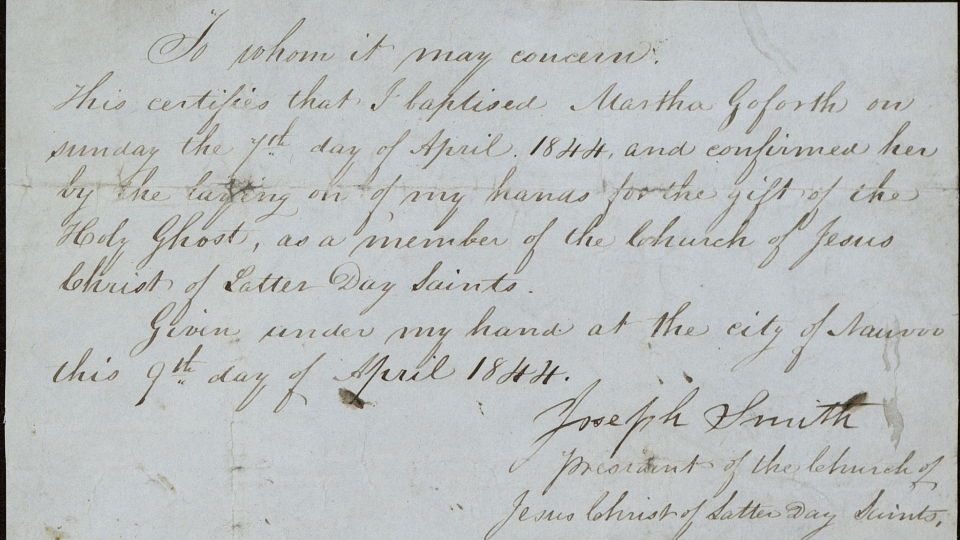
JSP-volume-14
This baptismal certificate shows that Joseph Smith baptized and confirmed Martha Nelson Goforth on April 9, 1844. Photo courtesy of Joseph Smith Papers.All rights reserved.
Between sessions in which he spoke, Joseph Smith participated in a baptismal service near his home in the Mississippi River where he baptized a woman named Martha Nelson Goforth. Historians know because he later signed her baptismal certificate.
“Baptismal certificates are unique in this time period, so it’s kind of rare and exciting that we have one, and that Joseph Smith himself signed it,” Nelson said. “You think about how busy he could have been and what was on his mind ... but in between sessions he performed a baptism.”
Joseph Smith the Poet
Another document in the volume features poetry by Joseph Smith.
Barbara Neff was 19 years old when her family came to Nauvoo. While in the city, she sought out several prominent Church members and asked them to sign her autograph book.
The book contains signatures by Brigham Young, John Taylor, the second and third Presidents of the Church; and Orson Hyde, an early member of the Quorum of the Twelve Apostles; and several poems by Eliza R. Snow, the second Relief Society general president, among others.
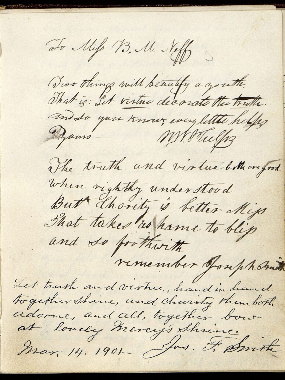
JSP-volume-14
This Joseph Smith Papers document features a short poem written by Joseph Smith. It was found in an autograph book once owned by a woman named Barbara Neff. Photo courtesy of Joseph Smith Papers.All rights reserved.Beneath a short poem and signature by William W. Phelps, Joseph Smith wrote his own poem:
“The truth and virtue both are good, when rightly understood
“But charity is better Miss, that takes us home to bliss
“and so forthwith, remember Joseph Smith.”
Neff’s family retained the autograph book for many years and got President Joseph F. Smith, sixth President of the Church, to sign right below his uncle in 1901.
“This is one of the coolest things I have ever held,” Nelson said of the autograph book.
Faith Rewarded
John and Catharine Paine Wilkie were Latter-day Saints living in the Nauvoo area in March 1844.
The historians said John Wilkie struggled for a time with the mounting turmoil in Nauvoo after hearing others criticize Joseph Smith. But with the support of his wife, he remained faithful and paid $300 cash as tithing.
To pay a sizable sum in cash like that was rare in those days. Most members paid tithing with chickens, clothing or other property, Petty said.
Joseph Smith rewarded Wilkie’s faith with a blessing that is now available for anyone to read.
Recorded Discourses
Historians don’t believe that Joseph Smith ever spoke from prepared notes.
What historians do have are notes recorded by those who heard his sermons. This volume includes documents that capture words from some of his discourses in early 1844.
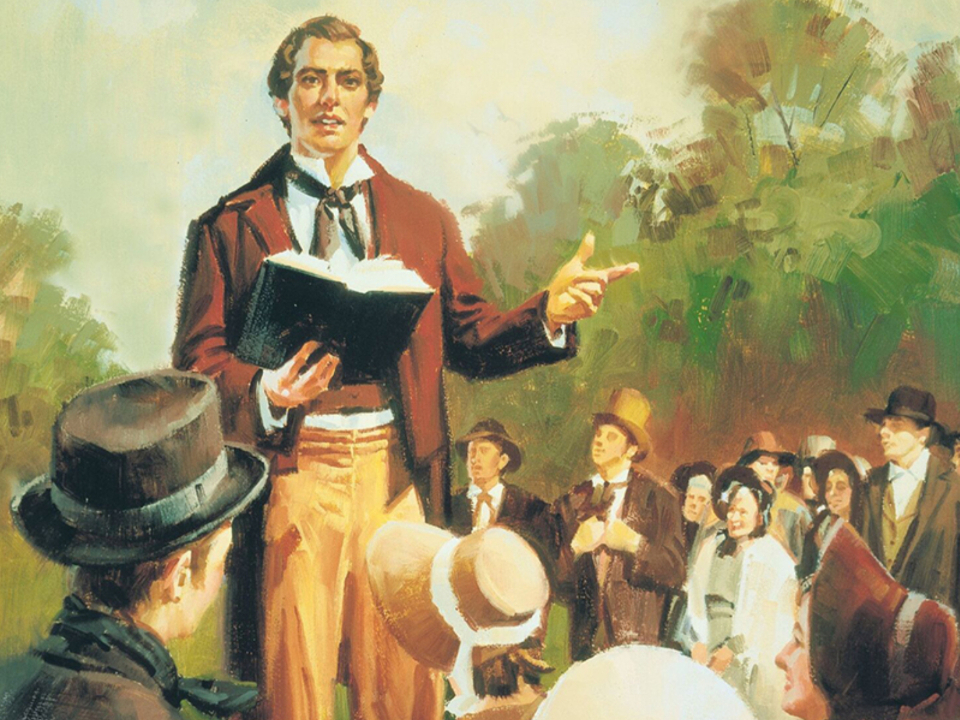
JS-volume-14
“Joseph Smith Preaching,” a painting by Sam Lawlor. 2023 by Intellectual Reserve, Inc. All rights reserved.
Speaking outside the unfinished Nauvoo Temple on Jan. 21, 1844, the Prophet expressed a little frustration with the Saints:
“There has been a great difficulty in getting anything into the heads of this generation. It has been like splitting hemlock knots with a corn-dodger [a piece of corn bread] for a wedge, and a pumpkin for a beetle [a wooden mallet]. Even the Saints are slow to understand. I have tried for a number of years to get the minds of the Saints prepared to receive the things of God, but we frequently see some of them, after suffering all they have for the work of God, will fly to pieces like glass as soon as anything comes that is contrary to their traditions. They cannot stand the fire at all. How many will be able to abide a celestial law and go through and receive their exaltation? I am unable to say, but many are called and few are chosen.”
On April 7, 1844, Joseph Smith delivered one of his best-recorded sermons at the funeral service of a Church member named King Follett. He spoke about death, the nature of God and eternal progression. He taught that God was once mortal and progressed to godhood, and men and women possess the same divine potential.
It’s important to understand the context of the King Follett discourse, Petty said. While a funeral sermon, Joseph was also defending his calling as a Prophet to some who considered him fallen. The message lasted two hours and was delivered in open air to thousands.
“On one hand, he is lifting them up to heaven, pulling back the veil and showing them these beautiful truths,” Petty said. “On the other hand, he’s parrying (with dissenters), warning them about consequences of their actions and warning the Saints not to follow them. He’s defending that ‘I am a true Prophet.’”
The Last Joseph Smith Papers Volume
The final installment of the Joseph Smith Papers is “Documents, Vol. 15, 16 May–28 June 1844” and covers the final six weeks of Joseph Smith’s life. It is scheduled to be released on June 27, 2023, the anniversary of the Prophet’s martyrdom.
Learn more about the Joseph Smith Papers at josephsmithpapers.org.
Copyright 2023 Deseret News Publishing Company.
